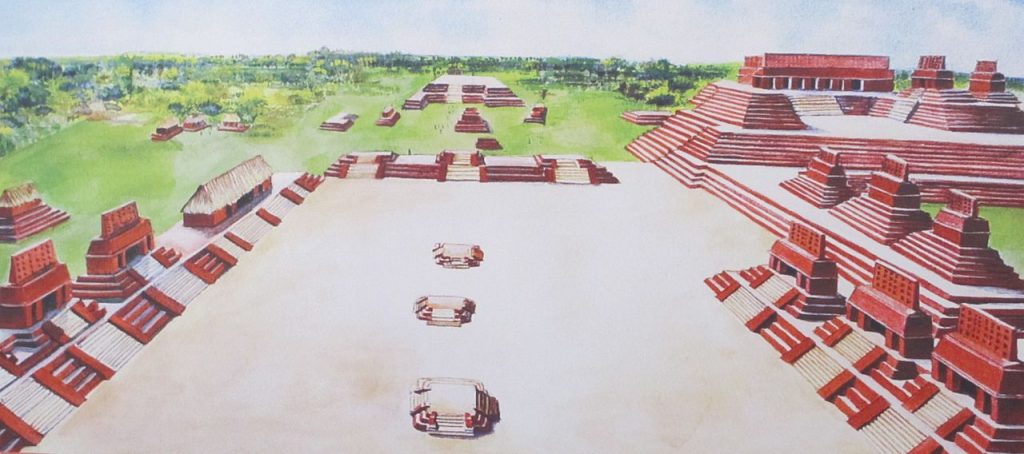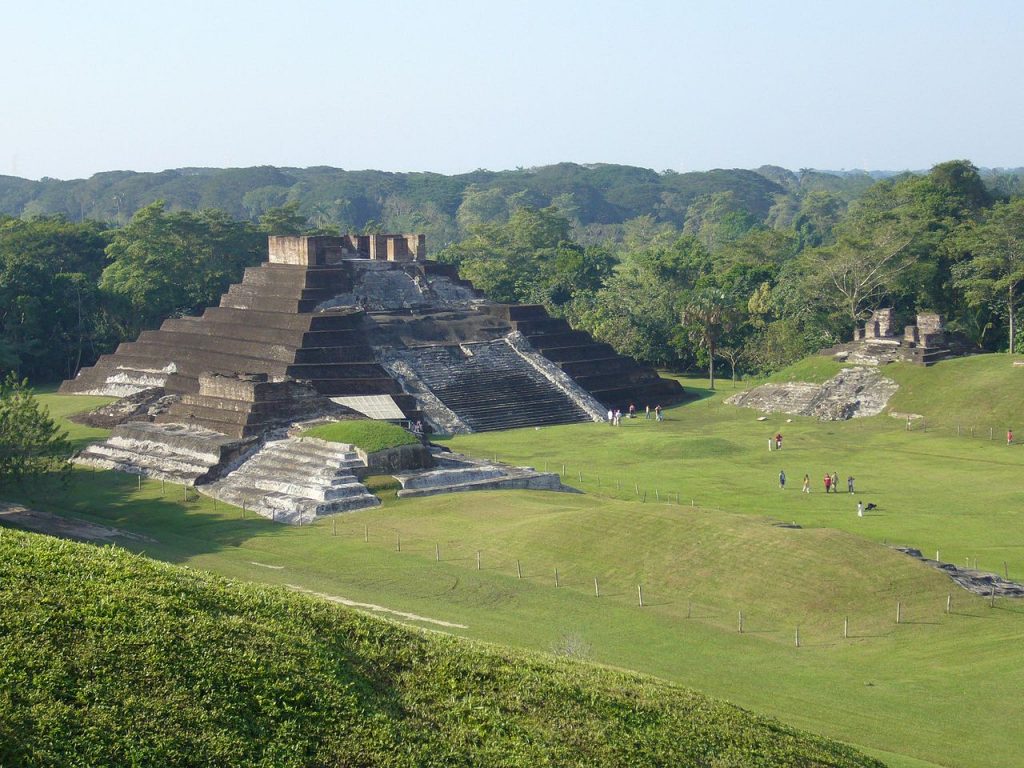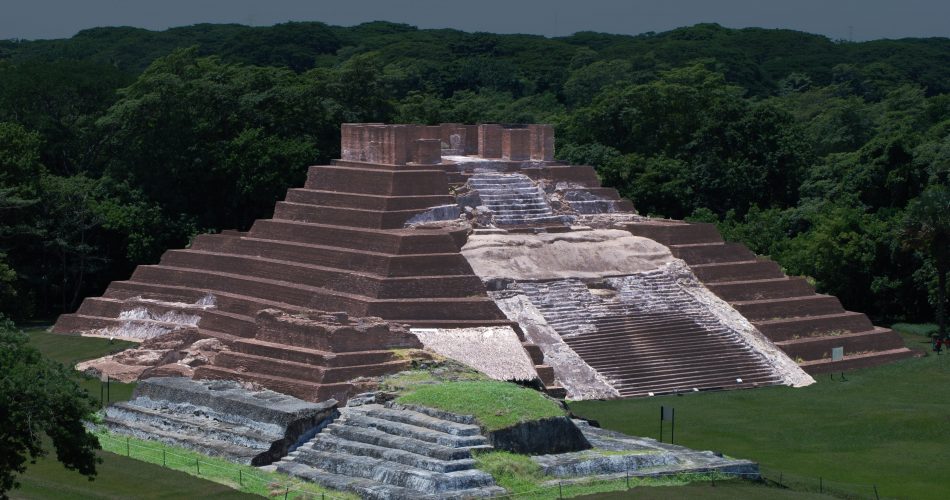- The Step Pyramid of Comalcalo is unique of all other ancient Maya pyramids because it was not built of limestone, but rather out of fired brick. The city of Comalcalo is the westernmost ancient city of the Maya.
- According to archeological surveys of the site, the fired bricks used in the construction of the pyramid bear strange symbols left behind by its builders that are “eerily similar” to ancient roman symbols.
- Experts argue that the fired bricks used to construct the pyramid resemble construction techniques employed by the ancient Romans, half-way around the world.
Thousands of years ago, the ancient Maya ruled over vast parts of present-day Mexico. Although the ancient civilization was centered in parts of the Yucatan Peninsula in Mexico, the country of Belize, Guatemala, and other regions of Central America, their influence spread as far as Teotihuacan, deep within the heart of central Mexico.
Covering an area of 7 square kilometers (2.7 sq mi), Comalcalco is thought to have been founded by the ancient Maya during the Late Classic period and probably served as a satellite or colony of the ancient city-state of Palenque. This theory is mostly based on architectural similarities between the two.
Its name derives for the Nahuatl language and the words comalli and calli. Therefore, Comalcalco means in Nahuatl “Place of the House of the Comales.” Comales are the pans that were used (and still are) to make tortillas.
A city like no other

Comalcalco’s ancient name is thought to have been Joy Chan which translates into “Round Sky” or “place with clouded Sky.”
This ancient city, tucked away in the swampy region of Mexico’s state of Tabasco and the city of Villahermosa, is the westernmost Mayan site identified to date. It denotes the very border of the ancient Maya territory.
Comalcalco–in addition to its main step pyramid known as Temple I–is home to hundreds of other structures which were also built of fired bricks.
This is unusual. If we take a look at Maya stone masonry, we will find that the Maya used carefully hew blocks of limestone to build their cities, temples, plazas, and pyramids. However, this was not the case with Comalacalo and its pyramids, most likely because there were no limestone deposits anywhere near the city.
Comalcalco is unique: to build this ancient city, the ancient Maya made use of local clay which they shaped into bricks. The ancient Maya would shape the bricks out of clay and then place them in a kind of kiln where the bricks were heated which made them much more durable. The bricks used in the construction of the ancient city’s pyramids and temples are of irregular dimensions which suggest they were not molded.
These bricks were called tabiques. The name of Comalcalco was given to the ancient site because of its vicinity to the town of Comalcalco located nearby. The people called the ancient city Colamcalo mostly likely because the bricks used in its construction resembles comales. Curiously, many of these bricks bear inscriptions that were either painted onto their surfaces or etched onto them. It has been reported that some bricks still have the fingerprints of the Maya builders that crafted them on their surface.
In total, it is thought that the ancient Maya constructed several hundred structures (to date 432) at Comalcalco using this technique. They would craft thousands of tabiques which were then used to build their temples, plazas, residential areas, and pyramids. To bind the bricks, the used a mortar that was created out of oyster shells which were most likely obtained from the Mecoacan Lagoon located not far from the site.
The main pyramid at the site, designated Temple I, rises from the fertile plateau to a height of around 20 meters.

In ancient times, the city was of great importance not only because of its strategic geographic location but because of the fertile lands that surround it. The region surrounding the city was once thought to have been covered by low evergreen rain forests that were interconnected by swamps. The city was built near the old Mezcalapa river which meant that the city was in control of important trading links between the Yucatan Peninsula and the Gulf of Mexico, as well as Guatemala’s highlands.
According to George Andrews, an archaeologist from the University of Oregon, since the ancient city was located inside of what is one of the largest cacao production zones in the region, the ancient inhabitants of the city most likely cultivated and traded the commodity extensively.
Comalcalco is thought to have reached its peak around 500 CE, some 1,500 years ago, although traces of habitation date back further in history. Archaeological studies have revealed that the city was an ancient industrial center where figurines, tools, and other artifacts were manufactured in mass production. It is likely that Comalcalco traded their goods with distant trade partners, evidence of which is a figurine found on Jaina Island, some 350 Kilometers away in the Yucatan Peninsula. This figurine has a match to the chemical composition of other figurines from Comalcalco.
The site was explored for the first time by foreigners in 1880 when Desire Charnay, a French archaeologist and explorer visited the site reporting “thousands of pyramids of colossal dimensions.”
A bricked mystery
As revealed by the website mexconnect, Comalcalco hides a mystery embedded deep within the bricks used to construct the site and its pyramids. According to reports, archaeologist Neil Steed who studied Comalcalco analyzed more than 5,000 bricks and photographed many of the inscriptions that were found on the surface of the bricks. Most of these signs are believed to be signs left behind by the builders, but there are certain symbols that stand out from the rest.
Some of these symbols, according to Mexconnect, are eerily similar to mason marks that builders in ancient Rome would leave behind. This similarity led Steed to conclude that “The illustrated bricks of Comalcalco are pieces to a grand puzzle, whose completed, the final image may reveal a Roman Christian presence in the Americas a thousand years before the arrival of Columbus.”
Furthermore, it has been suggested that the dimensions of the bricks used at Comalcalco tell another story. Their dimension, as well as architectural details, are more akin to roman construction than to Mayan styles. It has been implied that if this is the case, it would offer a Roman presence in Mexico that predates the arrival of Columbus by a thousand years. This, of course, is an unsupported theory unacknowledged by mainstream scholars.

